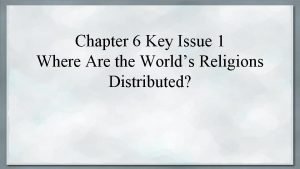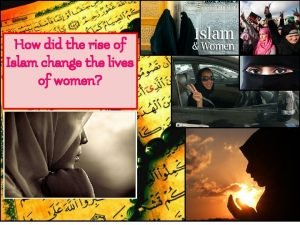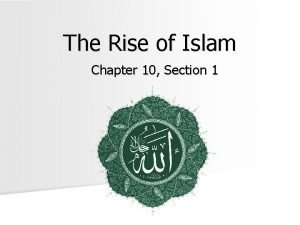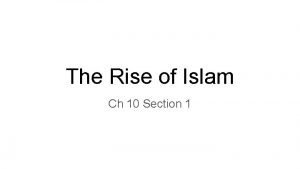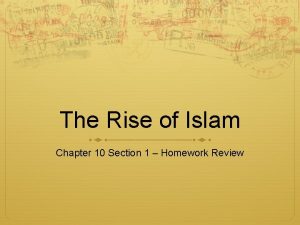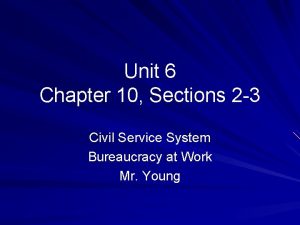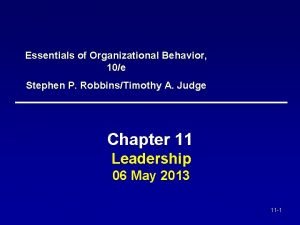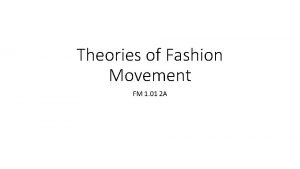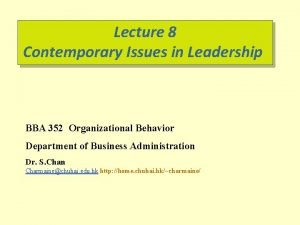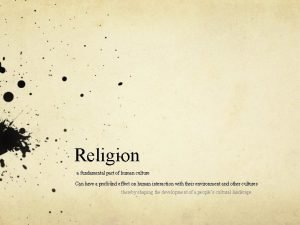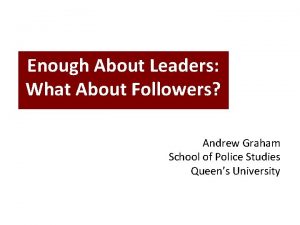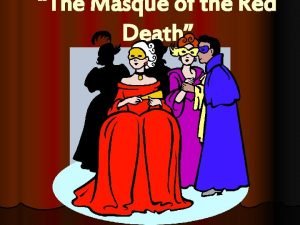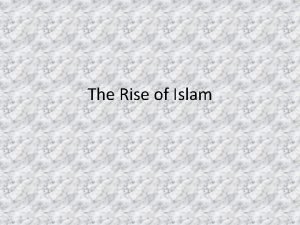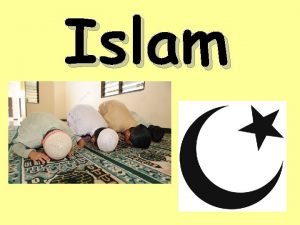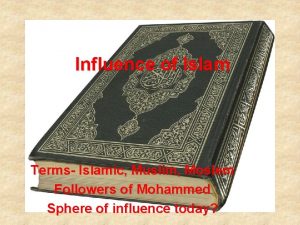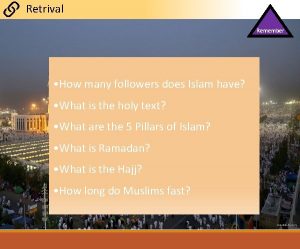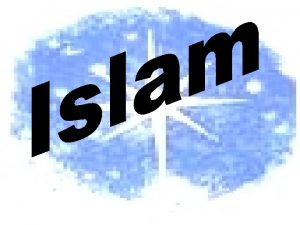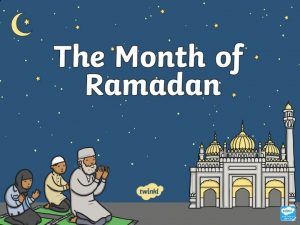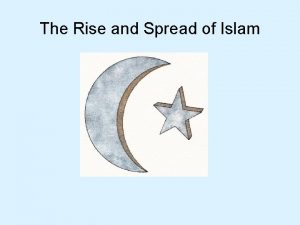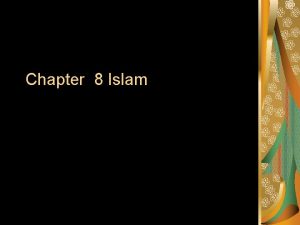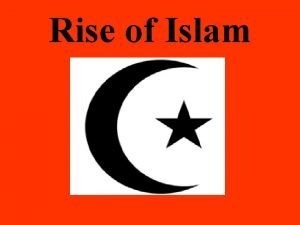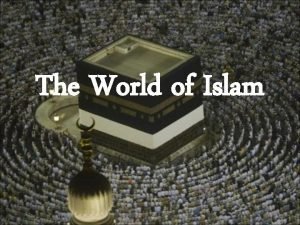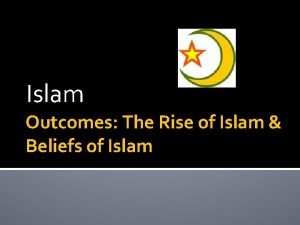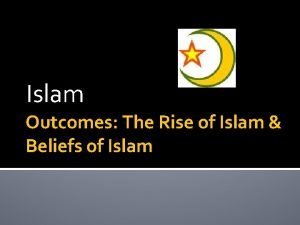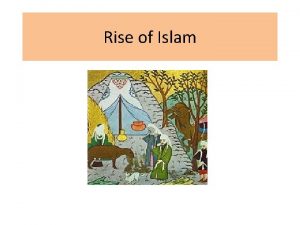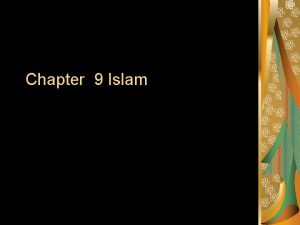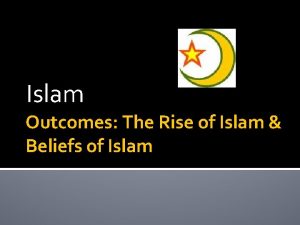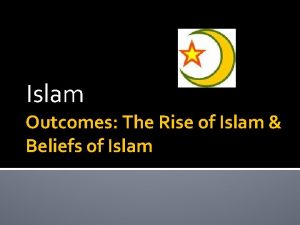ISLAM Sec 1 The Rise Followers of Islam















































- Slides: 47

ISLAM

Sec. 1, The Rise • Followers of Islam are Muslims • Started in Arabian Peninsula • Many Arab tribes around 500 A. D. living as nomads • BEDOUINS, nomadic herders, lived all around the desert looking for new pastures • Many tribes went to war with each other and traded • Muhammad born in Mecca around 570 A. D.



Muhammad • MECCA was a big market town and crossroads of several trade routes • Many Arabs pilgrimaged to Mecca to pray at the KABBA, an ancient temple of pagan gods and goddesses • No weapons inside, a safe place • Muhammad was a shepherd among Bedouins • Led caravans across the desert and successful merchant


God’s Messenger • Muhammad, 25, married Khadija who was a wealthy widow • Became known as honest and devoted family man • Disliked greed, meditated often near Mecca • Heard a voice from the angel Gabriel calling him to messenger of God • Muhammad was scared, puzzled • He was illiterate, Khadija told him to accept his duty • She was the first convert to Islam


Allah, Faith, Muhammad • Islam means submit to God in Arabic • Muhammad was devoted to spreading Islam • Forget polytheism and worship the ONE God, Allah • Many Arab’s became angered with Muhammad • Thought these new beliefs would hurt trade and the pilgrimage • Muhammad and his followers traveled to YATHRIB, today is known as MEDINA, “city of the Prophet”

Islam Goes BOOM! • The journey from MECCA to MEDINA becomes known as the HIJRA • People of Medina welcomed Muhammad and converted to Islam, Muslims (umma) • Loyalty shifted from families to the umma, community of Muslims • Muhammad writes rules, goal was to bring peace among the tribes • People of Mecca still rejected Muslims

War and Success • Muhammad returned to Mecca in 630 and defeated Meccans • Changed Kabba from Pagan temple to Holy Muslim temple of Allah • 632, Muhammad died, the Muslim faith continued to spread • The QURAN, sacred Muslim text, also mentioned other prophets like Jesus, Moses and Abraham


Quran and Duties • Quran is the word of God and teaches Muslim standards, penalties • Written in Arabic and all Muslims must learn Arabic • Muslims must also fulfill 5 duties (5 Pillars of Islam) in their faith • • • First: Declaration of Faith Second: Pray 5 Times Daily Third: Give Charity to the Poor Fourth: Fast From Sunrise to Sundown During Ramadan Fifth: Pilgrimage to Mecca, HAJJ


Lingo • MOSQUES are places of worship for Muslims • A muezzin leads the prayer • RAMADAN is the Islamic holy month • JIHAD, struggle in God’s service, overcoming immorality within one’s self • Do good things


Way of Life • Christians, Jews and Muslims all worship same monotheistic God • Often see eye to eye and considered to be “People of the Book” • Islam is a way of life • SHARIA is Islamic law that includes interpretation of the Quran • • Examples of behavior from Muhammad’s life Traditions Family life Government and business

Women • Covering, or veiling, of women is a Persian tradition of upper class women (adopted practices of conquered people, ROMANS) • Quran says women should dress modestly • In rural areas women work and do not wear a veil • Different in areas around the world


Sec. 2 Muslim Empire • The death of Muhammad set the Muslim religion into a frenzy • ABU BAKR should be the first CALIPH, successor to Muhammad • Told people to “worship God, God is alive” • Arab tribal leaders did not like Abu Bakr, refused to follow • Abu fought the Arabs was successful in reuniting them under Islam • Converted the rest of the Arab tribes through military force


Early Victories, Then Division • The first four caliphs won victory after victory • Surprised the Byzantines and Persians, obliterated the Persians completely • Took Damascus, Jerusalem, Syria and Palestine • Pushed the Byzantines into Egypt • Sunni vs. Shiite (USE SUNNI/SHIITE SHEET) • Muhammad’s son-in-law, shi’at Ali, should be successor --- SHIITES • Devote Muslim male from Muhammad’s tribe should be leader --- SUNNII

The Muslim Schism • The Sunni and Shiite is the same as the great Christian schism • Leads to many wars, death, depriving of wealth and power today when one leader is in office and persecutes the other (Iraq) • SUFIS are a part of both the Sunni and Shiite • They are the mystics who meditate and fast to seek communion with God • Help spread their faith and some are said to have great powers (equivalent to monks and nuns)

Umayyad and Caliphs • The UMAYYAD, a Meccan clan of Sunni caliphs that ruled the Muslim empire until 750 • Capital was Damascus in Syria • Ruled an empire from Spain to Morocco to the Indus Valley in the east • Moved into France at one point but lost to Frankish (YES! Best army ever!) forces in the battle of Tours • Attack the Byzantine empire many times as well

Why So Successful? • Factors: • • • The Byzantine and Persian empires were weak Had camel and horse riding forces that helped defeat the traditional empires Unified competing tribes under the first four caliphs Orderly system of government Treated conquered people fairly • Taxed people, but allowed Christians, Jews and Zoroastrians to practice their religions freely • Told their people to remain distant from the “natives” which created an upper-class • Many non-Muslims converted to gain power, Islam had no hierarchy and practiced a simple devotion to God

Decline • Problems for the Umayyad • Arabs had to adapt from living in the desert to ruling large cities • Caliphs ruled like tribal leaders not bureaucratic leaders • When battles and wealth slowed down, the economy slowed and could no longer support the caliphs’ lavish lifestyle • Shiites thought the caliphs of the Umayyad as illegitimate rulers • Non-Arabs began to resist because of fewer rights

Rise of Abbasids • Many Muslims found a leader in ABU AL-ABBAS, descended from Muhammad’s uncle • Strong support from Shiite, captured Damascus • Killed Umayyad family and started ABBASID dynasty that lasted until 1258 • Abbasid dynasty • Equality for all Muslims and ended military conquests • Caliphs reached peak wealth and power and civilization flourished

Abbasids and More • Abbasids also moved the capital of the empire from Damascus to Baghdad • Allowed Persian officials to hold more offices in the caliph’s government • Persian culture in the caliphate • Arabic was still the language and the head official became known as a vizier • The second Abbasid caliph, al-Mansur chose the site of BAGHDAD as the new capital

Baghdad • Baghdad was the place of the caliph’s temple • Walls around the city in a circle with the palace in the middle • Scholars, poets, philosophers and entertainers flocked there • The wealth of Baghdad exceeded Constantinople • “City of Peace, Gift of God, Paradise on Earth” • Domes and MINARETS, slender towers of mosques, dominated the skyline • Muezzins called for prayer five time a day from the minarets

Spain • The only survivor of the Umayyad family fled to Spain • He established a Muslim state in Spain • They where more tolerant than other religions • People came to the centers of learning, Cordoba, to practice philosophy and science • Jews and Christians were accepted • Muslim influence lasted in Spain until 1492

Muslim Empire Declines • Never ruled Spain and around 850 other leaders and groups were rising • Shiites came to power and invasions ensued • 900 s, Seljuk Turks migrated into the Middle East and Central Asia • Adopted Islam and built an empire around the fertile crescent (Iraq) • Took over Baghdad and a SULTAN, ruler, was the head and he kept the caliph and a figurehead • Began attacking Byzantine empire and prevented Christians fro going into Jerusalem • The First Crusade took place in 1095

Mongol Influence • The Mongols attacked over and over again in Central Asia • 1258, Hulagu (grandson of Genghis Khan) killed the last Abbasid caliph and burned Baghdad • 1300 s, Mongols adopt Islam and Tamerlane took his Mongol army in the Middle East • Claimed all of the Muslim empire and surrounding non-Muslim lands for himself • Also went into Southwest Asia, Russia and India

Sec. 4 Indian Muslims • India underwent a change when Islam reached it • • • Gupta empire fell in 550 and India broke into many kingdoms Hindu and Buddhists rulers excelled in making elaborate temples Trade networks opened up to Asia, China and Middle East Arabs took Indus Valley in 711 1000, Muslim Turks and Afghans pushed into India • Sultan Mahmud of Ghazni pillaged the North but did not settle • 1100 s, the SULTAN (Muslim ruler) of Ghur defeated Hindu armies and made DELHI his capital • Sultanate was developed and lasted from 1206 -1526, Muslims were in the north

Muslim Rule • Hindus lost because they had slow war elephants and the Muslims had mounted archers on horses • Hindus also wasted resources fighting each other • Low-caste Hindus converted to Islam • Government and society change • • Muslim traditions were incorporated Trade increase between India and Muslim land More Muslims became officials in India Mongol invasions in the Middle East forced many from Baghdad to India • Greek and Persian scholars came and influenced Delhi with art and architecture

Sultans, Hindu and Muslim Clash • 1398, Tamerlane invaded India and smashed Delhi • Delhi wasn’t the same and Sultans no longer ruled • The north was fragmented again and a war broke out between Hindus and Muslims • Buddhist and Hindu monasteries were smashed by Muslims • Many Buddhist and Hindus killed in an onslaught • Hindus believed in many gods and the caste system • Muslims believed in one god and that everyone is equal who worship God • Hindus also had music and dance

Blending • Muslims ultimately said that Hindu did have one ultimate God and accepted them • Hindus then allowed to practice their religion freely as long as they paid a tax • RAJAHS, or local Hindu rulers, were kept in place • Many Hindus converted to Islam still, no caste system, but absorbed some Hindu beliefs • Caste ideas, marriage, Urdu (a new language of Persian, Arabic, and Indian), art and music/dance • Nanak, Indian holy man, wanted to permanently blend the two religions under the “unity of God, ” brotherhood of man, rejection of the caste system and futility of idol worship • SIKHISM in northern India started, a blend of Hinduism and Muslim • Started a military to attack the Mughals (Muslims) of India

Mughal India • 1526, Turks and Mongols went into India, again • BABUR, descendent of Genghis Kahn and Tamerlane lead the invasion (military genius, poet and author of memoirs) • Babar founded the Mughal dynasty in Delhi, defeated the sultan Ibrahim • Mughals ruled from 1526 -1857 • Akbar the Great, Babur’s grandson really built up the Mughal Empire • 1556 -1605, he created a strong central government • Muslim who won support of the Hindus • Opened up opportunities for Hindus, government jobs and had Hindu princes in his council • Ended tax on non-Muslims • Consulted leaders of many faiths • Modernized the army, encouraged international trade, standardized weight and measure system and had land reforms

Akbar’s Successors • Jahangir was not as good as his father but his wife, Nur Jahan, took control of the government • She was able to lead by shrewd political judgment • Most powerful woman in India history, loved royal sports • SHAH JAHAN, Akbar’s grandson created the TAJ MAHAL after his wife who had born 14 children of his and he loved her very much • Wanted to create one for himself too, but his son imprisoned him and took his throne

Sec. 5 Ottoman and Safavid • The main three Muslim Empires in History: MUGHAL EMPIRE, OTTOMAN EMPIRE and SAFAVID EMPIRE • New weapons helped lead them to dominance • Cannons, muskets and reducing the mounted soldiers • More powerful foot soldiers • 1450 -1650, “Age of gunpowder empires” • The OTTOMANS, Turkish-speaking nomadic people who had migrated to Central Asia from Asia Minor • 1300 s, spread from Asia Minor into the Balkan Peninsula


Ottoman Expansion • Ottomans capture Constantinople • Mehmet II captured the city in 1453 • Brought ships over land launched into harbor near Constantinople • Changed name to Istanbul, ruled for 200 years • Sultan Suleiman brought a golden age to the Ottomans • Ruled from 1520 -1566, called “the Lawgiver” and Europeans called him Suleiman the Magnificent • Modernized military, conquered lands to the east and west • 1529, advanced into Vienna Austria, western Europe was scared • Failed to completely take Vienna though, but still largest empire in Europe and Middle East • He claimed to be the last Abbasid and caliph to all Muslims • “Protector of the Sacred Places, ” Medina and Mecca

Culture • Suleiman strengthened government and improved the justice system • Ruled with a grand vizier and council based on Sharia and edicts (order having the force of law) • Society was divided into classes • TOP: “men of the sword” – soldiers who guarded the sultan and defended the state • SECOND: “men of the pen” – scholars, scientists, lawyers judges and poets • THIRD: “men of negotiation” – merchants, tax collectors and artisans who carries out trade • BOTTOM: “men of husbandry” – farmers and herders who produced food for the community

Diversity and the Elite • There were many different people in the empire, diverse • Top classes were all Muslims, sword and pen, but other religions found a niche amongst the rest • People were organized into millets, or religious communities • Jews from Spain came in 1492 and brought banking connections, new technology for making cloth • Millet leaders handled education and some legal matters • JANIZARIES were the elite force for the Ottoman army • Christians were taxed and forced to give up their strong sons for military duty • The boys were converted to Islam and put through intense training for the army • Held high ranking positions in the military and sometimes became grand viziers • The non-Muslim girls were also converted and worked as maids in rich households

Art and Decline • Suleiman advanced arts and literature • Took traits from Persians and Arabians • Sinan, a janizary military engineer, designed mosques and palaces • Supposedly built a mosque better than Hagia Sophia • Like all good things, the Ottomans declined • Suleiman’s death in 1566 was the start • He killed two of his sons for suspected treason, his other son Selim II lead a corrupt bureaucracy • 1700 s, the Ottomans were getting left behind in technology and Ottoman lands were being captured by the Russia and other countries, leaders breaking away from the empire too

Safavid Empire • 1500 s, Safavid dynasty united the empire in Persia • Between Mughal and Ottoman empires geographically • Were Shiite Muslims, Ottoman were Sunni and constantly at war • Safavid king was a SHAH • SHAH ABBAS the great brought glory to Persia from 1588 to 1629 • Centralized government and created a powerful military like the Ottoman janizaries • Sought alliance with European states that feared the Ottomans • Used power and diplomacy

Reform and Decline • Abbas reduced taxes on farmers and herders, encouraged the growth of industry • He also tolerated non-Muslims and valued economic contributions • ISFAHAN became the new capital and center of the silk road • Armenians controlled the silk road and he brought them to Isfahan, Christians had own self run community • Shah Abbas died and Ottomans were pressuring the empire

Decline • Shiite scholars were questioning the rule of the shah • Stressing their own policies of law and government • Encouraged persecution of other religions • Pushed Sunni Afghans to rebel • Rebels captured Isfahan and forced the last Safavid ruler out in 1722 • The QAJARS won Iran and made TEHRAN the capital until 1925 and the Safavids were done
 Followers of islam
Followers of islam Little lambs academy
Little lambs academy Rise and rise again until lambs become lions origin
Rise and rise again until lambs become lions origin Rise and rise again
Rise and rise again Tricky dicky richard nixon
Tricky dicky richard nixon How did the rise of islam change the lives of women?
How did the rise of islam change the lives of women? Rise of islam timeline
Rise of islam timeline Chapter 10 section 1 the rise of islam
Chapter 10 section 1 the rise of islam The rise of islam chapter 10 section 1
The rise of islam chapter 10 section 1 Chapter 10 section 1 the rise of islam
Chapter 10 section 1 the rise of islam House's path-goal theory
House's path-goal theory Military industrial complex
Military industrial complex Be ye followers of god
Be ye followers of god How do charismatic leaders influence followers
How do charismatic leaders influence followers Trickle-down theory fashion
Trickle-down theory fashion Contemporary leadership roles
Contemporary leadership roles Followers of primal indigenous ethnic religions do not
Followers of primal indigenous ethnic religions do not Kellerman followership model
Kellerman followership model Why do prince prospero and his followers retreat
Why do prince prospero and his followers retreat How do charismatic leaders influence followers
How do charismatic leaders influence followers Buddhism number of followers
Buddhism number of followers A good leader will have followers who ______.
A good leader will have followers who ______. Passive followership
Passive followership Why did christianity attract so many followers?
Why did christianity attract so many followers? Perkataan abbasiyyah diambil sempena nama
Perkataan abbasiyyah diambil sempena nama Pengertian perundangan islam
Pengertian perundangan islam Matlamat sistem perundangan islam
Matlamat sistem perundangan islam đặc điểm cơ thể của người tối cổ
đặc điểm cơ thể của người tối cổ Mật thư anh em như thể tay chân
Mật thư anh em như thể tay chân Bổ thể
Bổ thể Tư thế worm breton
Tư thế worm breton ưu thế lai là gì
ưu thế lai là gì Thẻ vin
Thẻ vin Thể thơ truyền thống
Thể thơ truyền thống Cái miệng xinh xinh thế chỉ nói điều hay thôi
Cái miệng xinh xinh thế chỉ nói điều hay thôi Các châu lục và đại dương trên thế giới
Các châu lục và đại dương trên thế giới Từ ngữ thể hiện lòng nhân hậu
Từ ngữ thể hiện lòng nhân hậu Tư thế ngồi viết
Tư thế ngồi viết Diễn thế sinh thái là
Diễn thế sinh thái là V. c c
V. c c Làm thế nào để 102-1=99
Làm thế nào để 102-1=99 Chúa sống lại
Chúa sống lại Sự nuôi và dạy con của hổ
Sự nuôi và dạy con của hổ đại từ thay thế
đại từ thay thế Quá trình desamine hóa có thể tạo ra
Quá trình desamine hóa có thể tạo ra Vẽ hình chiếu vuông góc của vật thể sau
Vẽ hình chiếu vuông góc của vật thể sau Công thức tiính động năng
Công thức tiính động năng Tỉ lệ cơ thể trẻ em
Tỉ lệ cơ thể trẻ em
